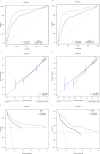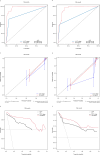Construction and validation of novel nomograms based on the log odds of positive lymph nodes to predict the prognosis of papillary thyroid cancer: a retrospective cohort study
- PMID: 40123892
- PMCID: PMC11925767
- DOI: 10.3389/fendo.2025.1411426
Construction and validation of novel nomograms based on the log odds of positive lymph nodes to predict the prognosis of papillary thyroid cancer: a retrospective cohort study
Abstract
Objective: This study aims to assess the long-term prognostic significance of the log odds of positive lymph nodes (LODDS) in patients diagnosed with papillary thyroid cancer (PTC) and to develop a novel nomogram for predicting long-term overall survival (OS).
Methods: The cohort was randomly divided at a ratio of 7:3 from the Surveillance, Epidemiology, and End Results (SEER) database. Additionally, patient data from a medical center in China served as an external validation cohort. Nomograms were constructed using data from the training cohort and subsequently validated using both internal and external validation cohorts to predict 120- and 180-month OS in PTC patients. The predictive performance and clinical utility of the nomogram were assessed using various metrics, including the concordance index (C-index), time-dependent receiver operating characteristic (ROC) curves, calibration curves, decision curve analysis (DCA), Integrated Discriminant Improvement Index (IDI), and Net Reclassification Improvement Index (NRI).
Results: LODDS is an independent prognostic factor for PTC, a nomogram demonstrating high accuracy in predicting long-term OS. The C-index values, and time-dependent area under the curve (AUC) indicated well discriminatory ability of the nomogram. Calibration plots exhibited high concordance, while DCA, NRI, and IDI analyses revealed superior performance of the nomogram compared to AJCC staging system.
Conclusion: The clinical prediction model incorporating LODDS exhibits robust predictive performance, aiding in the assessment of long-term prognosis post-surgery in PTC patients. It serves as a valuable adjunct to the AJCC system, offering a scientific basis for guiding interventions and rehabilitation strategies for PTC patients following surgery.
Keywords: SEER; long-term overall survival; nomogram; papillary thyroid cancer; post-operative.
Copyright © 2025 Jing, Song, Di, Xiao, Ma and Wu.
Conflict of interest statement
The authors declare that the research was conducted in the absence of any commercial or financial relationships that could be construed as a potential conflict of interest.
Figures






Similar articles
-
Dynamic nomograms combining N classification with ratio-based nodal classifications to predict long-term survival for patients with lung adenocarcinoma after surgery: a SEER population-based study.BMC Cancer. 2021 Aug 4;21(1):653. doi: 10.1186/s12885-021-08410-6. BMC Cancer. 2021. PMID: 34344326 Free PMC article.
-
Construction and Validation of a Nomogram Based on the Log Odds of Positive Lymph Nodes to Predict the Prognosis of Medullary Thyroid Carcinoma After Surgery.Ann Surg Oncol. 2021 Aug;28(8):4360-4370. doi: 10.1245/s10434-020-09567-3. Epub 2021 Jan 19. Ann Surg Oncol. 2021. PMID: 33469797
-
Development and validation of a nomogram for predicting cancer-specific survival in small-bowel adenocarcinoma patients using the SEER database.World J Surg Oncol. 2024 Jun 7;22(1):151. doi: 10.1186/s12957-024-03438-x. World J Surg Oncol. 2024. PMID: 38849854 Free PMC article.
-
Dynamic survival outcomes of the tall-cell variant of papillary thyroid carcinoma patients after surgery.Front Endocrinol (Lausanne). 2025 Mar 24;16:1517907. doi: 10.3389/fendo.2025.1517907. eCollection 2025. Front Endocrinol (Lausanne). 2025. PMID: 40196456 Free PMC article.
-
A prognostic nomogram based on log odds of positive lymph nodes to predict the overall survival in biliary neuroendocrine neoplasms (NENs) patients after surgery.J Endocrinol Invest. 2022 Dec;45(12):2341-2351. doi: 10.1007/s40618-022-01874-8. Epub 2022 Jul 30. J Endocrinol Invest. 2022. PMID: 35908009
References
Publication types
MeSH terms
LinkOut - more resources
Full Text Sources
Medical

